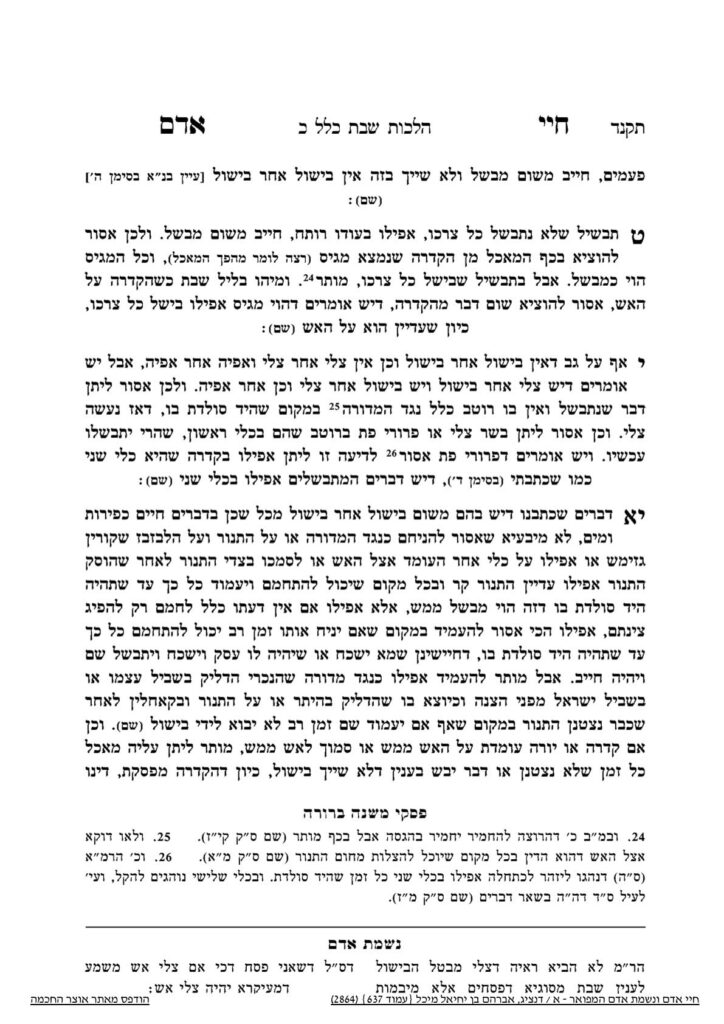We have finished siman 11, where the Chayei Adam concluded by discussing placing an empty pot over the fire and heating food on top of the empty pot. The Chayei Adam held that the empty pot functions better than garuf v’katum, and it can be used for nesinah lechatchilla. We learned that according to the Mishnah Berurah, the empty pot is the equivalent of garuf v’katum, and not better. Therefore, according to the Mishnah Berurah, chazarah is muttar but nesinah lechatchilla is not. We added that this is the source for the concept of a blech. Today, we will discuss the concept of the blech further.
Chazal were concerned that if one leaves food on the fire when going into Shabbos, a person may come to stoke the coals out of concern that the food will not be hot enough by their Friday Night meal. There is a machlokes tannaim as to when this concern applies. Chananya holds that if the food is basically ready to eat–even if it is not optimally cooked–one will not forget themselves, so there is no concern of chazarah. “Basically ready to eat” is defined as maachal ben derusai. The chachamim disagree, and hold that even if it is at the level of maachal ben derusai, one may forget themselves and stoke the coals.
There are two ways to solve the concern that one will come to stoke the coals, both for Chanayan and the chachamim at their respective level of concern. One is to remove all of the coals before Shabbos. The oven will still retain its heat, since their ovens were made with thick walls, but there will be nothing to stoke. This is known as garuf. The second solution is to cover the coals with ash, known as katum. Covering the coals solves the concern of stoking the coals because since a person generally does not place ash on top of their coals, the ash will serve as a hekker to remind the person it is assur to stoke them.
Many poskim write that, as we no longer have coals, but cook on top of gas or electric burners, therefore, if one places a piece of metal on top of the fire, the metal will serve as a hekker to remind the person not to stoke the fire, ie.e., raise the temperature of the fire. Thus, our blechs constitute katum.
The Chazon Ish disagrees, and holds that katum does not just serve as a hekker, but also serves to minimize the heat going to the pot. The ash blocks oxygen from getting to the coals, minimizing their heat. He understands that the hekker of katum is to lower the temperature of the fire so that one remembers it is Shabbos. If so, according to the Chazon Ish, a blech does not work unless it minimizes the heat. Metal is inherently a good conductor of heat, so it certainly does not minimize the heat. We will discuss the solution according to the Chazon Ish in the upcoming shiur, be’ezras Hashem.
Summary
According to the Chayei Adam, nesinah lechatchila (and certainly chazarah) will be muttar by placing an empty pot on top of the fire. Although we do not pasken like the Chayei Adam regarding nesinah lechatchilla, we accept the heter regarding chazarah.
This heter is the source for a blech. The empty pot functions as katum, covering the coals to create a hekker. Thus, the poskim write that placing a metal sheet on top of the fire serves the same purpose. Accordingly, the blech will allow for chazara according to the Mishnah Berurah, but not for nesinah lechatchila.
The Chazon Ish adds that part of the hekker of katum is that it minimizes the heat, so there would need to be an equivalent in a blech as well. We will discuss this point further in the upcoming shiur.



